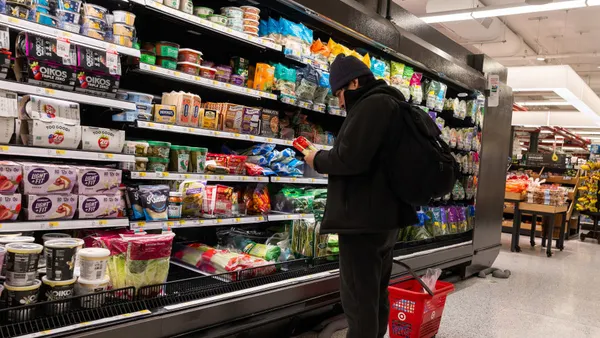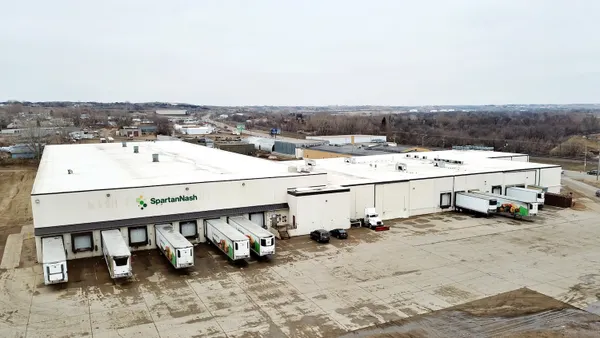Dive Brief:
- Grocers face a bleak future as they continue to face price pressure and competition around the globe, a new report from McKinsey predicts. According to the firm, sales growth in the grocery sector has grown just 2% over the last decade in North America and Western Europe, and from 2012 to 2017 more than half of the grocery sector’s economic profit disappeared.
- The report attributes disruption in the industry to consumers’ changing habits and preferences, intensifying competition, and new technologies. If retailers don’t make some serious changes, they could see anywhere from $200 billion to $700 billion in grocery spending to discount, online and non-grocery channels by 2026.
- Though challenging, McKinsey says the disruption can be overcome by those who make the right moves, and the report sets forth six imperatives where retailers can make improvements to combat this possible fall and remain profitable.
Dive Insight:
Race-to-the-bottom pricing and widespread competition among lower-cost store formats have obliterated grocers’ margins in recent years, according to McKinsey. Alternative formats such as dollar stores, discount non-grocers and online ecosystems like Amazon have intensified the pressure and drawn shoppers, especially millennials and baby boomers.
McKinsey predicts that consolidation, which is on the rise since 2016, will be one way for grocery companies to combat this disruption, but that could mean the demise of as many as half of all conventional grocers. Those who want to succeed will need to be inventive, agile and decisive, with specific action on six key imperatives.
The first imperative mentioned in the report calls for grocers to define themselves with a distinct value proposition that incorporates convenience, inspiration and monetary value. Arguably, this is what every grocer is struggling to do in today’s competitive landscape, especially as they try to offer something different from Amazon or Walmart.
Next, the firm recommends that grocers adapt to the online ecosystem and either embrace e-commerce, or get out of the game. This may be brutally honest, but with online grocery sales expected to quadruple in the next five years, it’s a reality that grocery companies have to face. A few traditional retailers like Walmart have already gained significant traction in online grocery with advancements in click and collect, delivery services, and autonomous technology. Several others, such as Smart & Final and Giant have updated store formats to improve e-commerce.
Another area for improvement is adoption of technology in every part of the value chain, including customer engagement, product assortment and operations. McKinsey recognizes that some grocers are already taking action here, noting that Kroger, for example, is offering personalized promotions and deals for shoppers through the use of technology. But personalization isn’t just for marketing messages and offers — it can be taken further into personalized product recommendations and content. The report suggests that personalization for shoppers can result in a top-line impact of up to 2%.
Technology can also enhance in-store, back office and warehouse operations, according to the report. Up to half of in-store tasks have the potential to be automated, including taking inventory, checking out, stocking shelves and assembling salads and sandwiches. Warehouse operations can also be automated, with little to no staff required. McKinsey uses Kroger’s partnership with Ocado as an example, and recent news also suggests that retailers such as Ahold Delhaize and Schnucks are giving technology and robotics a try to streamline operations.
Grocers will also need to win shoppers back through freshly prepared foods and easy meal options, the firm says, as well as through creative store layouts. As the industry has seen in the last year alone, grocers are well aware of these needs. A host of U.S. retailers has gotten on board to offer convenient, freshly prepared foods and add additional food service to their stores, including Albertsons, Publix and its new GreenWise Market stores as well as Winn-Dixie.
Finally, McKinsey rounds out its list of imperatives with a call for speed, saying retailers must innovate ten times faster. The report proposes “concept sprints,” which requires quick decision making, tangible outcomes and a focus on multidisciplinary teams. Simply put, grocers need to drastically pick up the pace when it comes to bringing changes to their stores and meeting, or anticipating, customer needs.
While many grocers are scrambling to survive, others are clearly excelling in many of the areas McKinsey outlines in its report. There is, no doubt, more change ahead — but it could be change for the better to create a grocery industry that delivers value and better connects with shoppers.













